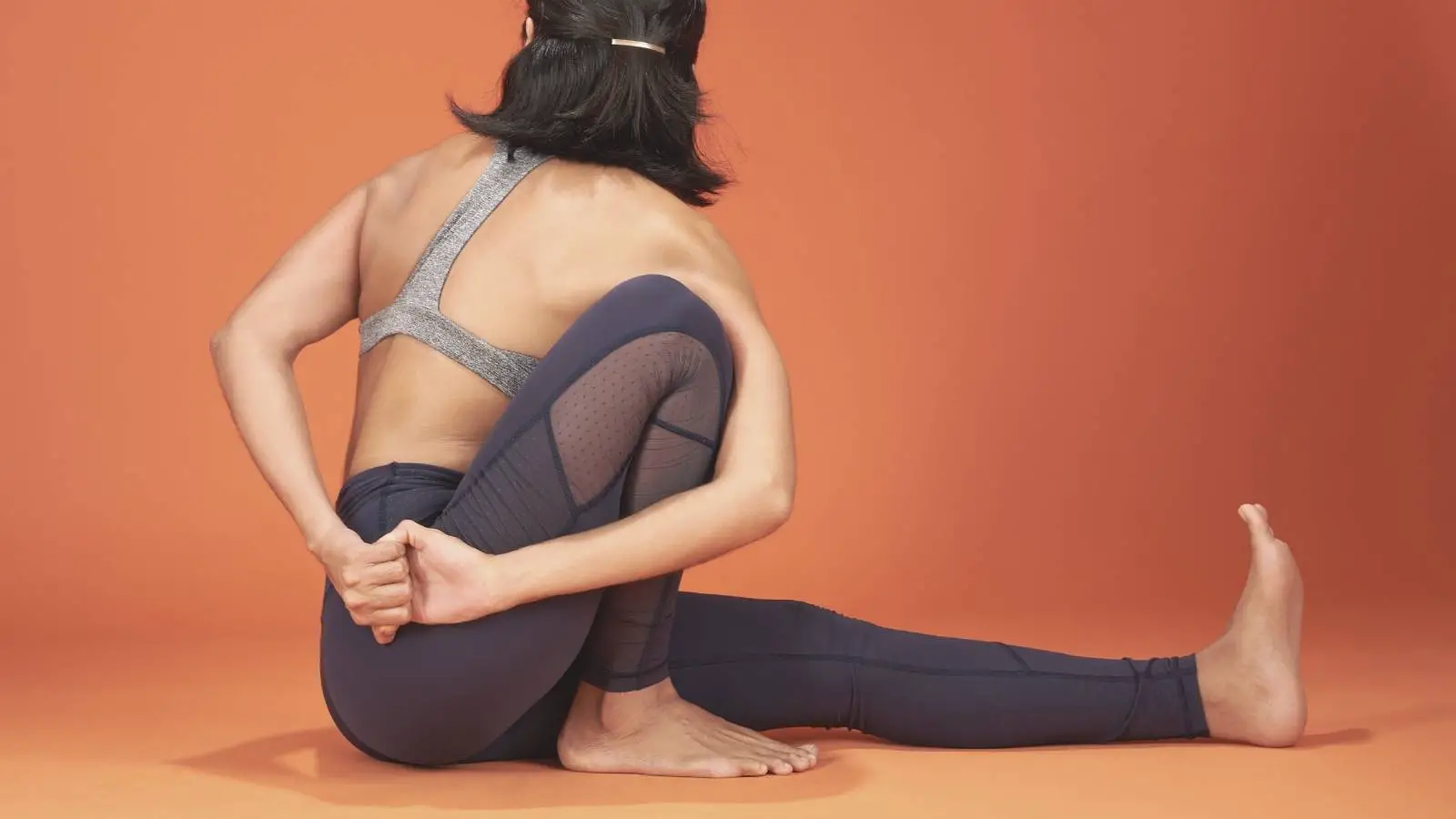Binding in yoga practice is an enjoyable and exciting way to explore taking your classic poses to a new level. A bind can deepen your usual poses and can enhance its effects. Binds can put a lot of pressure on the body and joints, particularly in the back and shoulders, so it’s essential to properly warm up before attempting any binding poses.
This article aims to highlight some of the essential tips on how to improve your yoga binds. We will go over some information about yoga binds and some of the best ways to improve your overall yoga experience. You’ll also learn some of the best tips on how to prepare your body for doing binding yoga poses.
What is Binding in Yoga?
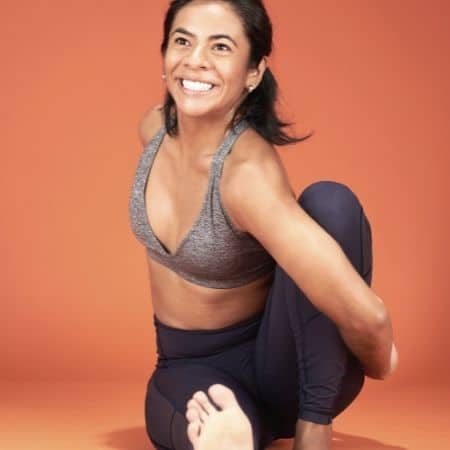
Binding in yoga refers to any action where one part of the body holds on to another part. Or it can relate to when two body parts are intertwined with each other.
When binding is done correctly, it allows the body to relax and will enable you to hold a deeper, more creative pose for a more extended amount of time. Binds can also help you to maintain the structural integrity of the poses, which makes them safer.
However, not everyone can easily bind. Learning the art of binding takes time. It would be best if you gradually built up to your binding poses rather than trying to force yourself right into them. There are also several things that you can do before your yoga practice to prepare your body for binding poses.
We will go over some tips on preparing your body for binding and some of the best ways to work towards performing some of the more difficult binding poses later in this article.
Why Should You Bind in Yoga?
Binds have the benefit of physically deepening the pose and the effects of your yoga poses. Binds can offer more significant rotation, a fuller fold, or a more profound hip opener or backbend.
They offer another way to approach balance and alignment in yoga by encouraging you to make self-adjustments in the process. This can put you in the role of a teacher. Binding can offer exciting and fun variations to some of the classic yoga poses. Exploring binds in yoga is enjoyable and provides a significant variation of pose styles.
Binding also opens out your chest, allowing you to take deep and calming breaths during the process. Focusing on deep, purposeful breaths is an integral part of any yoga routine.
Some Expert Tips on How to Improve Your Yoga Binds
If you are thinking about exploring binds in your yoga practice, consider following some of these tips to help improve your yoga binds:
Begin Your Yoga Session with a Proper Warm-Up
No matter what kind of exercise you’re doing, it’s always best to make sure you get a proper warm-up beforehand. Binding in yoga can be challenging, and so it is never a good idea to attempt it when you’re cold or not adequately warmed up.
It doesn’t matter how flexible you are. It would be best if you always warmed up first for safety and to make the process of binding much more manageable.
Before practicing yoga binds, do some simple warm-up stretches to get your muscles moving more freely, and then move into some heating rounds of Sun Salutes.
Try the following stretch – going from a plank to Chaturanga to Upward-Facing Dog and then Downward-Facing Dog. This is a great way to stretch your spine and strengthen your arms, wrists, and shoulders. It is also a great way to cultivate a rhythmic breathing type. These are all things that you will need to master to bind successfully.
If you follow up this warm-up with some lunges or other standing poses, you can ensure that your legs are stretched. This will also help to release any tightness in your hips.
Be Sure to Check in with Your Back and Shoulders
Your shoulders and back are critical in yoga, especially in binds, so you need to make sure these are appropriately warmed up to safely wrap your arms in bind poses. If your back and shoulders are tight, then you can risk hurting yourself if you push the bind too soon. Don’t let your ego get the better of you.
Your Sun Salutes will prepare your back and shoulders for the moves. However, you can also further release the tension in these areas by doing target poses and movements such as the Cow Face Post, the Eagle and by clasping your hands behind your back. You want your back and shoulders to be relaxed, ready for your binds.
Look at Where You Are and Practice Non-Harming Techniques
If you are currently dealing with any tightness or injuries, then it is best not to try to complete full binds until you are recovered. Instead, you can try focussing on a different variation of the binding pose, or you can try using props to ensure you don’t sustain further injuries from the poses.
Adapting your binding poses in this way will help to support you and your body without risking any further injuries.
Open Up Your Heart
If you choose to bind in your yoga sessions, then you need to open up your heart to the movements. Just as the sutra Sukham Asanam invites, you need to seek both ease and steadiness in your binding poses.
You should aim to keep your heart expansive during your movements and poses rather than closed up. Try to focus on ensuring that you maintain space along your chest and collarbones. You also need to try to resist the urge to allow the shoulder to collapse, come forward, or rise up to your ears.
Your warm-ups aim to prepare your body for your binding poses, so you don’t want to ruin that by closing off your shoulders and chest during the routine.
Be Sure to Nurture Fluid Breathing
In order to maintain both comfort and strength in your binding poses, you need to focus on calm fluid breaths. If your breathing is erratic, comes out in big gasps, or if you find that you’re holding your breath, then this is a clear sign that you need to focus on your breathing. You need to create that space required from within.
You may be wondering how to create the relevant internal space when you’re quite literally all bound up. This is where paying close attention to your body comes in really handy. While you’re in a binding pose, you should explore some careful and mindful self-adjustments to help deepen the overall experience. This will help you to improve the pose and will also help to support your much-needed fluid breathing.
Treat Your Yoga as a Healing Practice.
It’s so easy to get wrapped up in the art of binds, especially as more and more people are starting to share their journeys of discovering binds through the likes of social media.
However, it is essential to remember that the real intention of yoga is healing. So with that in mind, if you’re not ready to bind or take on the physical limitations of binding, then you should choose another pathway. Find a yoga practice that best works for your personal mind, body, and soul.
Look at your yoga routine and find your own challenges that have the most benefits for you, rather than trying to do the most challenging variation of a particular pose. Yoga is all about exploring the power of your mind, body, and soul together, so find what works for you and flow with it.
Incorporate Meditation into Your Practice
It is thought that the art of yoga was initially intended to open up the body so that it makes sitting for longer meditations more comfortable. Focusing on your body is a great way to get out of your head.
Practicing meditation and yoga can help you feel much more calm and relaxed and can improve your mind and concentration, which allows you, when it comes to holding yoga, poses for longer.
Stay Motivated
As with any physical activity, you may find yourself feeling up and down about yoga. Sometimes you may need to take a break from it, whether that be because of injury, other obligations, or travel.
This is entirely normal, and you shouldn’t be lead to believe that just because you’re having a break, it means your life with yoga is over. Yoga is something that you can come back to time and time again. If you’re feeling bored with your yoga practice, try mixing in some new moves.
Staying motivated with your yoga and continuing to work on your poses is a great way to improve your binds. Don’t give up just because you’re finding it difficult. Stay on track, and you’ll find that your flexibility, mind, and body all improve significantly over time.
Make Use of Yoga Straps

Yoga straps can be very beneficial for a number of reasons. They are great for beginners as they can help you to improve your flexibility while allowing you to achieve poses with greater balance.
Yoga straps are great when it comes to warm-ups, as you can use them to ensure that every part of your body gets a good warming up. If there is an area that you struggle with, or if you have a particular area of tension, a yoga strap can help to relieve some of the tension and help you to get a more significant warm-up stretch.
Yoga straps are also great for binding poses. If you can’t quite grasp a binding pose, a yoga strap can come in very handy as you can clasp onto the strap in a way that is comfortable for you instead of having to force your hands together in a binding position.
You can use the strap to slowly bring your hands close and close together each time you make a particular move, improving your overall flexibility and making it easier to work your way into the more challenging poses.
Work on Your Flexibility
Flexibility, particularly in the back, legs, and shoulders, is an integral part of successfully performing binding yoga moves. To improve your body ready for binds, you can try to work on your flexibility outside of yoga.
Focus on stretching your body and working on improving your flexibility in everyday life. Perform stretches every day to keep your body loose. Even just some simple arm rotations and leg flexes can be hugely beneficial when it comes to performing and maintaining binding yoga poses.
Why Is Binding So Beneficial in Yoga?
There are many things that binding can help to improve. Below are some of the main benefits of binding:
Binds Open the Heart and Chest
Any of the yoga poses that involve moving one of your hands around your back and the other under your leg externally rotates the arms and pushes the shoulder blades closer together. The tension that this causes opens the chest up and deepens your posture, allowing your heart to shine outward. The benefit of a lot of binding poses is that it causes the heart to expand outwards.
Benefits in Organ Massage and Digestion
When you perform a binding twist pose, you can maintain the pose for much longer. Yoga, in general, has many internal benefits by stretching and opening up the internal organs. Adding binds to the poses can further enhance these benefits.
Mental Balance Benefits
Binding allows you to strike a balance between struggling and striving. Working yourself into a pose can cause a lot of frustration and can even cause you to injure yourself. You should instead choose to strive towards your binding goals.
This means basically working towards the bind in a way that respects both your mind and body at that moment. A bind pose should never feel forced. Instead, you should work your way up towards binding poses until you feel entirely comfortable performing them. This mental stability in yoga binds very beneficial.
Straightening and Strengthening the Spine
Cradling your feet in a bind or performing a yoga pose where the head goes down to the knees ensures that the spine is straight with your heart open and forward. This type of yoga pose is excellent for strengthening and straightening the back while also helping to improve your overall posture.
Relaxing Your Muscular Tensions
One of the most significant benefits of yoga binds is that they allow your muscles to release, relax, and open up. By relaxing during your intense yoga stretches, you can gain a lot more benefit from the pose. You will find that incorporating binds into your yoga poses can help to strengthen your muscles, as well as help to align and perfect your posture.
Some Common Yoga Poses with Binds
Below is a list of some common yoga poses with binding incorporated. The poses below range from beginner to advance, so you can give them a go and see which works best for your particular level.
Be aware that yoga binds put a lot of pressure on the shoulders, and the poses should never be forced. You should only do what is comfortable for you.
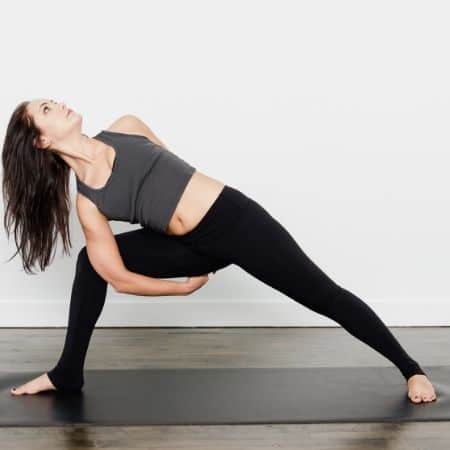
Bound Extended Side Angle Pose
The extended side angle pose is a beginner yoga pose that is usually taught quite early on. You can wrap this pose by binding your torso and front leg while rotating your chest and shoulders.
To do this, you will need to lower your front shoulder beneath your knee before wrapping your arm under the front leg and up part of your back. To thoroughly perform this bind, your knee will need to be bent at a 90-degree angle.
Your bottom hand will clasp onto the top wrist outside of your right hip. This then rotates your top shoulder back and twists your body upwards.
Bound Forward Fold
This pose involves standing and bending all the way forwards until your shoulders pass your knees. You will then wrap your arms around both of the legs and interlock your fingers resting at the bottom of your back.
This is quite a difficult pose if you are new to yoga or if you don’t quite have the flexibility to do the full bend. The trick is to work with what you’ve got. Don’t force the move. If you find that you can’t bend forward enough, then you can work on that. Try doing the moving each day, and you’ll find that you improve over time until you can entirely do the binding pose.
Bound Warrior Three
Adding a bind to the classic warrior three poses is a great way to open up the chest and can also help you to counterbalance the pose, making it easier to keep the pose going for longer.
To do this, you should interlock your fingers behind you before stepping into the warrior three poses. This will help you to glide gracefully into the correct position. For those more advanced in their yoga techniques, you could try transforming the pose into a toppling warrior three poses by leaning your chest closer to the floor as you lift your leg and hands closer to the ceiling.
Bound Yogi Squat
This pose involves performing a yogi squat and then binding the arms under the thigh and around the back. This helps to open up the chest and shoulders, ready for more intense poses.
It is essential to take notice of your breathing during this binding pose to ensure that you aren’t pulling the joints too far. Binding can be uncomfortable; however, it should never be painful. Be aware of your body and respond accordingly.
Bound Half Moon
This bind acts as an extension to the extended side angle pose. While in the extended side angle pose, turn your gaze downwards and then press down on your front foot and slide your back foot forward. Extend and lengthen the side of your body before lifting your back foot up for the half-moon post.
To help with balance, try lifting the back leg up and leaning in opposite directions to help keep you steady. While trying binding poses, it’s essential to find what works for you personally, so play around with it until you find what is comfortable for you.
How to Prepare Your Body for Yoga Binds
In order to complete binds in a safe and effective way, you need to fully prepare your body beforehand. Below are some tips on how to prepare your body ready for performing yoga binds:
Most Important: The Shoulders
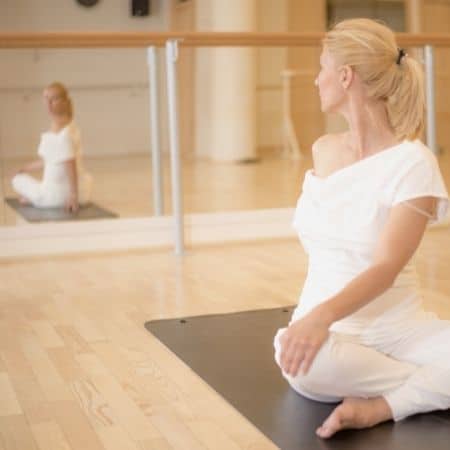
Twisted binds can be very complicated and can put a lot of strain on your arms, particularly in the shoulder area. Before you choose to perform a bind, it is important to consider the pose and think about where the shoulders are going to be and how much the pose is going to affect them.
The direction of movement in the shoulders for most binding moves is internal rotation and adduction. Many people lack the ability to move freely in this motion, so a lot of strain can be placed on the shoulder joints.
A good trick is to look at your back in the mirror. If you find that your shoulder blade is protruding during your movement, this means that you are putting a strain on the wrong parts of the shoulder joint. While it’s not really injurious to perform movements in this way, it is not the way to perform a true rotation of the shoulder joint, and it is not a stable position for the shoulder to be in.
The best way that you can work on preparing for your binding poses is to try doing the poses slowly with a strap and watching your shoulder blades carefully in a mirror. Do they pose as far as you can with your hands together before the shoulder blades start to show?
Once you get to this point, then work in the action of energetically pulling your hands apart on the strap. This will put a load onto both of your shoulder joints and will help you to adapt your shoulder joints to the correct ranges.
The Dynamics of a Healthy Binding Twist
Shoulder mobility is the main requirement of performing successful and safe binds in yoga; however, you will also need mobility in other areas. Spinal mobility in the direction of rotation is important for good binds. Hip mobility is also important. This is why it is essential to ensure that you are fully warmed up all over before attempting any yoga binds.
To best prepare your body for binds, you should first practice some non-bound revolved lunges with some gentle twists. This can help loosen both your back and your legs and hips, ready for more intense movements later on.
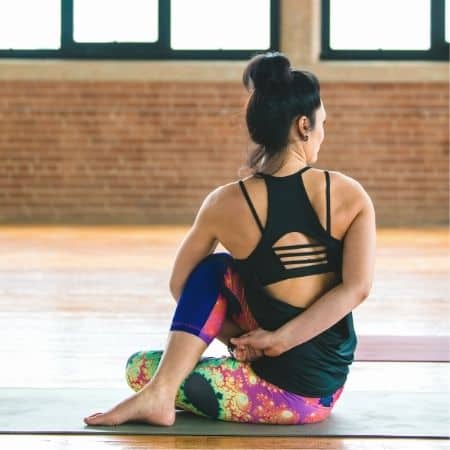
To perform a healthy twisted lunge, you should begin with a high lunge with your left foot forward and your arms extended upwards towards the sky. Feel your spine lengthening but avoid bending your back in any way. From there, you should bring your left hand down to your hip and hinge forward around halfway, still remaining to keep your spine lengthened.
Continuing to maintain that lengthy spine, laterally flex to the left, without bending your back at all. Then, you should begin to rotate your rib cage to the left. Eventually, you can hook your right elbow onto the outside of your left knee and come into a prayer twist.
Practicing twists like this can help you to strengthen your spine, ready for future binding poses. Do go into a deep twist right away. You should instead work slowly and breathe into your twists. Repeat this stretch on both sides until you feel that your body is loose and warmed up enough to perform more intense poses.
Final Thoughts
As you explore binding in yoga practice, it is important to remember the importance of warming up and working towards your yoga binding goals. You can’t expect to be a pro at yoga binds from the get-go.
There are many ways in which you can improve your binding techniques, such as using yoga straps in your poses, focusing on your breathing, and fully preparing your body before going into the binding poses.
The art of binding is a process that takes time to master. However, once you do, you’ll feel all of the benefits of your internal body opening up and improving. If you are interested in yoga, binding is something a little bit different that adds a whole range of new poses to your classic yoga routine.

